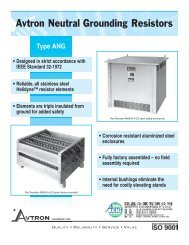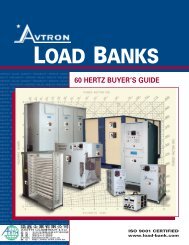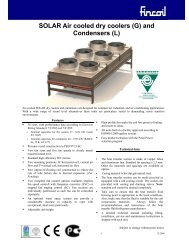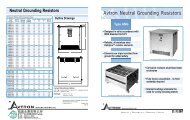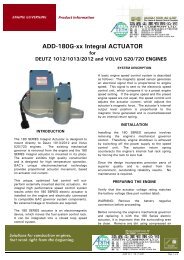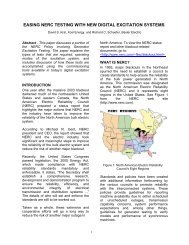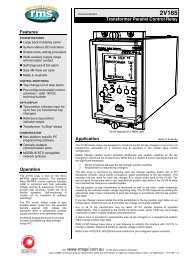ENGINE GOVERNING SYSTEMS LSM672 LOAD SHARING MODULE
ENGINE GOVERNING SYSTEMS LSM672 LOAD SHARING MODULE
ENGINE GOVERNING SYSTEMS LSM672 LOAD SHARING MODULE
You also want an ePaper? Increase the reach of your titles
YUMPU automatically turns print PDFs into web optimized ePapers that Google loves.
Terminals 1-6 accept for the 3 PHASE VOLTAGE inputs.Selection of the proper 3 terminals is dependent on thegenerator voltage. See Specification, page 2.CAUTION.HIGH VOLTAGE PRESENTAT TERMINALS N & 1-6TERMINAL STRIP COVER MUSTBE IN PLACE WHEN IN OPERATIONTerminals 7-12 accepts the 3 PHASE CURRENT input from5 amp current transformers. Series connections can bemade from instrument panel CTs providing the VA rating isadequate. The CT burden of the load sharing module is6.25 VA for each phase. This will add to the burden rate ofthe panel instruments and wiring on the CTs. Note the commonCT connections at terminals 8,10 and 12. This isrequired for CE approved applications.Terminals 13 and 14 are the PARALLEL CABLE connectionswhich link all load sharing modules together. Properpolarity must be observed. If these cables are longer than3 ft. (1 m) they must be shielded with the shield groundedat Terminal 23. The relay contacts used must be suitable forlow current levels, < 1 ma (Dry contacts).Terminal 15 is the load sharing OUTPUT TERMINAL to thegovernor system speed control unit. If this cable connectionis longer than 3 ft (1 m), it must be shielded. Ground theshield at Terminal 23.Terminal 16 is the FORWARD POWER RESET A momentaryconnection to a +10 VDC source on the governorspeed control using a normally open switch will automaticallyreset the forward power relay to the OFF condition.Connecting Terminal 16 to battery negative turns on themonitor. The forward power monitor may also have programmedswitch points through Terminal 16. Connecting a1 megaohm resistor between Terminal 16 and batteryminus (terminal 23) shifts a 100% ON/40% OFF settingdown to a 85% ON/5% OFF setting. If different programmingis required, consult GAC’s engineering for assistance.Terminals 17 and 18 are for a REVERSE POWER RESETmomentary switch. The unit is factory shipped with ajumper connected, for automatic reset. This automaticreset will cause the internal relay will remain energized onlywhen the reverse power level is above the reverse powerset point.The reverse power relay can be setup to latch and then bemanually reset by an external switch at terminals 17 to 18with the following modification. Install a soldered wire linkbetween posts E4 and E5 on the circuit board. The postsare accessible by removing the unit’s cover. See Diagram1 for post positions.Replace the factory installed jumper between Terminals 17and 18 with a N.C. momentary switch. The reverse powerrelay and sensing circuit will reset to the OFF conditionwhen switch is opened.Terminals 19 and 20 are the REVERSE POWER RELAYOUTPUT TERMINALS. Contacts are N.O. and rated for10 amps (LED lights).Terminals 21 and 22 are the FORWARD POWER RELAYOUTPUT TERMINALS. Contacts are N.O. and rated for10 amps (LED lights).Terminal 23 is the battery negative connection and is connectedto the ground reference terminal at the control unit.Do Not connect directly to battery minus or a ground loopwill be formed.Terminal 24 is connected to the positive side of a 24 voltbattery supply.Terminal 25 provides a D.C. voltage proportional to thepower output of the generator set. Ground reference isTerminal 23. Further information may be found in the sectionon the Power Output Signal.PRE-PARALLELING CHECKS1. Load Sharing Sensitivity adjustment — Full clockwiseposition.2. Load Anticipation adjustment — 1/4 turn from full counterclockwise(OFF) position.3. Governor Speed Set point — trim to desired speedsetting.4. CT Phasing check requires DC voltage measurements.Measure across the test posts (TP1 and TP2) observinginstrument polarity, TP1, the lower post, is (+). This voltageis directly proportional to unity P.F. load. A voltage of0 to 7.5 VDC can be expected, depending on load, LoadSharing Sensitivity adjustment, and CT ratios.With the generator set under load, check the CT phasingmomentarily and sequentially short each CT one at a time,with an insulated lead at Terminals 7-8, 9-10, or 11-12.Each time a CT is independently shorted, the voltagereading will be reduced by 1/3. If the voltage change is not1/3, this very likely indicates improper CT or voltage phasing.Corrections to CT phasing must be performed whilethe generator set is not running.CAUTIONDO NOT OPEN CIRCUIT CT CONNECTIONSWHILE THE GENERATOR SET IS RUNNING,HIGH VOLTAGE WILL BE PRESENT.INSURE TO REPLACE, TERMINAL BLOCKCOVER AFTER ALL WIRING IS COMPLETED.ADJUSTMENTSWith the generator paralleled to the other generator(s)and with no load on the system, adjust each generatorsspeed setting using the governor speed trim control forzero power as indicated on each generator sets wattmeterand proper system frequency (50,60 or 400 Hz). Also,adjust the generators AC voltage regulators setting forzero circulating AC current. Electrical load can now beapplied to the system.-5-



